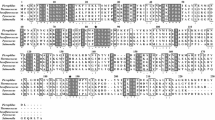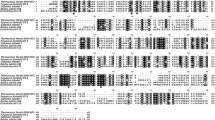Abstract
We succeeded in expressing the aspartate racemase homolog gene from Thermococcus litoralis DSM 5473 in Escherichia coli Rosetta (DE3) and found that the gene encodes aspartate racemase. The aspartate racemase gene consisted of 687 bp and encoded 228 amino acid residues. The purified enzyme showed aspartate racemase activity with a specific activity of 1590 U/mg. The enzyme was a homodimer with a molecular mass of 56 kDa and did not require pyridoxal 5′-phosphate as a coenzyme. The enzyme showed aspartate racemase activity even at 95 °C, and the activation energy of the enzyme was calculated to be 51.8 kJ/mol. The enzyme was highly thermostable, and approximately 50 % of its initial activity remained even after incubation at 90 °C for 11 h. The enzyme showed a maximum activity at a pH of 7.5 and was stable between pH 6.0 and 7.0. The enzyme acted on l-cysteic acid and l-cysteine sulfinic acid in addition to d- and l-aspartic acids, and was strongly inhibited by iodoacetic acid. The site-directed mutagenesis of the enzyme showed that the essential cysteine residues were conserved as Cys83 and Cys194. d-Forms of aspartic acid, serine, alanine, and valine were contained in T. litoralis DSM 5473 cells.




Similar content being viewed by others
Abbreviations
- AspR:
-
Aspartate racemase
- DTT:
-
Dithiothreitol
- KPB:
-
Potassium phosphate buffer
- LB:
-
Luria-Bertani
- PLP:
-
Pyridoxal 5′-phosphate
- PCR:
-
Polymerase chain reaction
- SDS:
-
Sodium dodecyl sulfate
References
Aihara T, Ito T, Yamanaka Y, Noguchi K, Odaka M, Sekine M, Homma H, Yohda M (2016) Structural and functional characterization of aspartate racemase from the acidothermophilic archaeon Picrophilus torridus. Extremophiles 20(4):385–393
Andreotti G, Cubellis MV, Nitti G, Sannia G, Mai X, Marino G, Adams MW (1994) Characterization of aromatic aminotransferases from the hyperthermophilic archaeon Thermococcus litoralis. Eur J Biochem 220(2):543–549
Aswad DW (1984) Determination of d- and l-aspartate in amino acid mixtures by high-performance liquid chromatography after derivatization with a chiral adduct of o-phthaldialdehyde. Anal Biochem 137(3):405–409
Choi SY, Esaki N, Yoshimura T, Soda K (1992) Reaction mechanism of glutamate racemase, a pyridoxal phosphate-independent amino acid racemase. J Biochem 112(1):139–142
D’Aniello A, Di Cosmo A, Di Cristo C, Annunziato L, Petrucelli L, Fisher G (1996) Involvement of d-aspartic acid in the synthesis of testosterone in rat testes. Life Sci 59(2):97–104
Fadda E, Danysz W, Wroblewski JT, Costa E (1988) Glycine and d-serine increase the affinity of N-methyl-d-aspartate sensitive glutamate binding sites in rat brain synaptic membranes. Neuropharmacology 27(11):1183–1185
Fujii T, Yamauchi T, Ishiyama M, Gogami Y, Oikawa T, Hata Y (2015) Crystallographic studies of aspartate racemase from Lactobacillus sakei NBRC 15893. Acta Crystallogr F Struct Biol Commun 71(Pt 8):1012–1016. doi:10.1107/S2053230X15010572 (epub 28 Jul 2015)
Fujii T, Sato A, Okamoto Y, Yamauchi T, Kato S, Yoshida M, Oikawa T, Hata Y (2016) The crystal structure of maleylacetate reductase from Rhizobium sp. strain MTP-10005 provides insights into the reaction mechanism of enzymes in its original family. Proteins. doi:10.1002/prot.25046
Gogami Y, Ito K, Kamitani Y, Matsushima Y, Oikawa T (2009) Occurrence of d-serine in rice and characterization of rice serine racemase. Phytochemistry 70(3):380–387
Gogami Y, Okada K, Oikawa T (2011) High-performance liquid chromatography analysis of naturally occurring d-amino acids in sake. J Chromatogr B Anal Technol Biomed Life Sci 879(29):3259–3267
Kita A, Tasaki S, Yohda M, Miki K (2008) Crystal structure of PH1733, an aspartate racemase homologue, from Pyrococcus horikoshii OT3. Proteins 74:240–244
Lambert MP, Neuhaus FC (1972) Mechanism of d-cycloserine action: alanine racemase from Escherichia coli WV. J Bacteriol 110:978–987
Lineweaver H, Burk D (1934) The determination of enzyme dissociation constants. J Am Chem Soc 56:658–666
Liu L, Iwata K, Kita A, Kawarabayasi Y, Yohda M, Miki K (2002) Crystal structure of aspartate racemase from Pyrococcus horikoshii OT3 and its implications for molecular mechanism of PLP-independent racemization. J Mol Biol 319(2):479–489
Long Z, Lee JA, Okamoto T, Sekine M, Nimura N, Imai K, Yohda M, Maruyama T, Sumi M, Kamo N, Yamagishi A, Oshima T, Homma H (2001) Occurrence of d-amino acids and a pyridoxal 5′-phosphate-dependent aspartate racemase in the acidothermophilic archaeon, Thermoplasma acidophilum. Biochem Biophys Res Commun 281(2):317–321
Ma K, Robb FT, Adams MW (1994) Purification and characterization of NADP-specific alcohol dehydrogenase and glutamate dehydrogenase from the hyperthermophilic archaeon Thermococcus litoralis. Appl Environ Microbiol 60(2):562–568
Matsui D, Oikawa T, Arakawa N, Osumi S, Lausberg F, Stäbler N, Freudl R, Eggeling L (2009) A periplasmic, pyridoxal-5′-phosphate-dependent amino acid racemase in pseudomonas taetrolens. Appl Microbiol Biotechnol 83:1045–1054
Matsumoto M, Homma H, Long Z, Imai K, Iida T, Maruyama T, Aikawa Y, Endo I, Yohda M (1999) Occurrence of free d-amino acids and aspartate racemases in hyperthermophilic archaea. J Bacteriol 181(20):6560–6563
Neuner A, Jannasch HW, Belkin S, Stetter KO (1990) Thermococcus litoralis sp. nov.: a new species of extremely thermophilic marine archaebacterial. Arch Microbiol 153:205–207
Oikawa T, Tauch A, Schaffer S, Fujioka T (2006) Expression of alr gene from Corynebacterium glutamicum ATCC 13032 in Escherichia coli and molecular characterization of the recombinant alanine racemase. J Biotech 125:503–512
Okada H, Yohda M, Giga-Hama Y, Ueno Y, Ohdo S, Kumagai H (1991) Distribution and purification of asparate racemase in lactic acid bacteria. Biochim Biophys Acta 1078:377–382
Rudnick G, Abeles RH (1975) Reaction mechanism and structure of the active site of proline racemase. Biochemistry 14(20):4515–4522
Shibata K, Watanabe T, Yoshikawa H, Abe K, Takahashi S, Kera Y, Yamada RH (2003) Purification and characterization of aspartate racemase from the bivalve mollusk Scapharca broughtonii. Comp Biochem Physiol B Biochem Mol Biol 134(2):307–314
Toogood HS, Hollingsworth EJ, Brown RC, Taylor IN, Taylor SJ, McCague R, Littlechild JA (2002) A thermostable l-aminoacylase from Thermococcus litoralis: cloning, overexpression, characterization, and applications in biotransformations. Extremophiles 6(2):111–122
Uchida Y, Hayashi H, Washio T, Yamasaki R, Kato S, Oikawa T (2014) Cloning and characterization of a novel fold-type I branched-chain amino acid aminotransferase from the hyperthermophilic archaeon Thermococcus sp. CKU-1. Extremophiles 18(3):589–602
Watanabe S, Tanimoto Y, Nishiwaki H, Watanabe Y (2015) Identification and characterization of bifunctional proline racemase/hydroxyproline epimerase from archaea: discrimination of substrates and molecular evolution. PLoS One 10(3):e0120349
Yamashita T, Ashiuchi M, Ohnishi K, Kato S, Nagata S, Misono H (2004) Molecular identification of monomeric aspartate racemase from Bifidobacterium bifidum. Eur J Biochem 271:4798–4803
Yamauchi T, Choi SY, Okada H, Yohda M, Kumagai H, Esaki N, Soda K (1992) Properties of aspartate racemase, a pyridoxal 5'-phosphate-independent amino acid racemase. J Biol Chem 267(26):18361–18364
Yoshida T, Seko T, Okada O, Iwata K, Liu L, Miki K, Yohda M (2006) Roles of conserved basic amino acid residues and activation mechanism of the hyperthermophilic aspartate racemase at high temperature. Proteins 64(2):502–512
Acknowledgments
We thank Mr. Taro Hirozane for his construction of pET 11b-Tl-aspr. This study was supported in part by the Ministry of Education, Culture, Sports, Science and Technology (MEXT)—Supported Program for the Strategic Research Foundation at Private Universities, 2013–2017. This research was financially supported in part by the Kansai University Grant-in-Aid for progress of research in graduate course, 2015.
Author information
Authors and Affiliations
Corresponding author
Additional information
Communicated by H. Atomi.
Rights and permissions
About this article
Cite this article
Washio, T., Kato, S. & Oikawa, T. Molecular cloning and enzymological characterization of pyridoxal 5′-phosphate independent aspartate racemase from hyperthermophilic archaeon Thermococcus litoralis DSM 5473. Extremophiles 20, 711–721 (2016). https://doi.org/10.1007/s00792-016-0860-8
Received:
Accepted:
Published:
Issue Date:
DOI: https://doi.org/10.1007/s00792-016-0860-8




